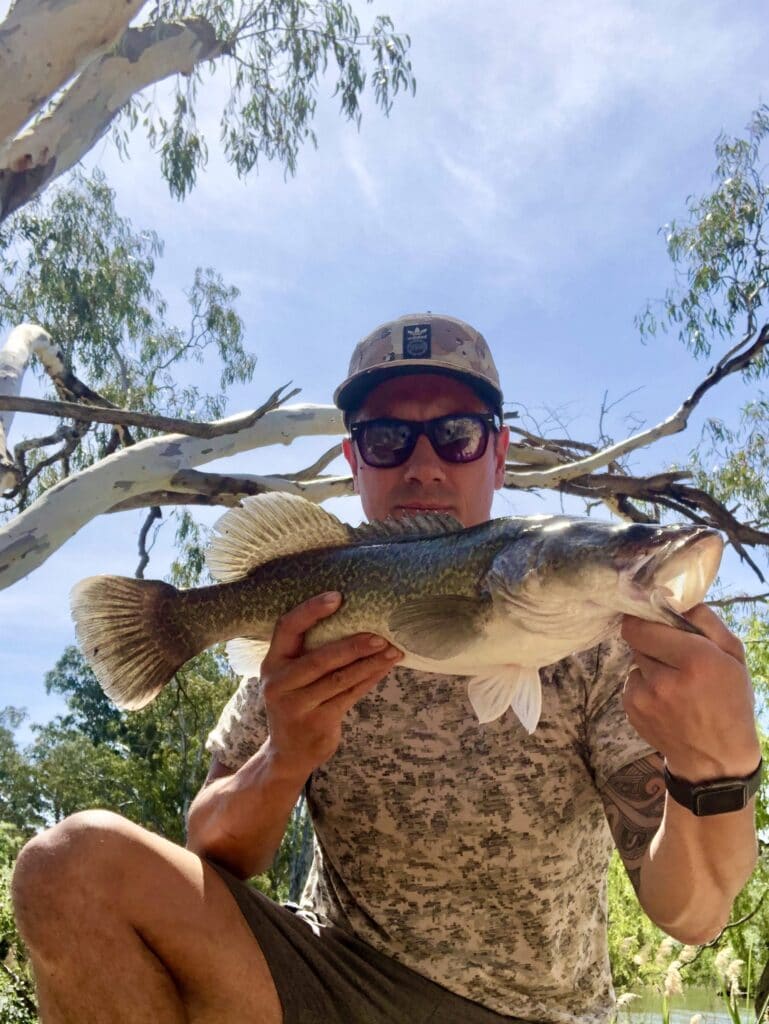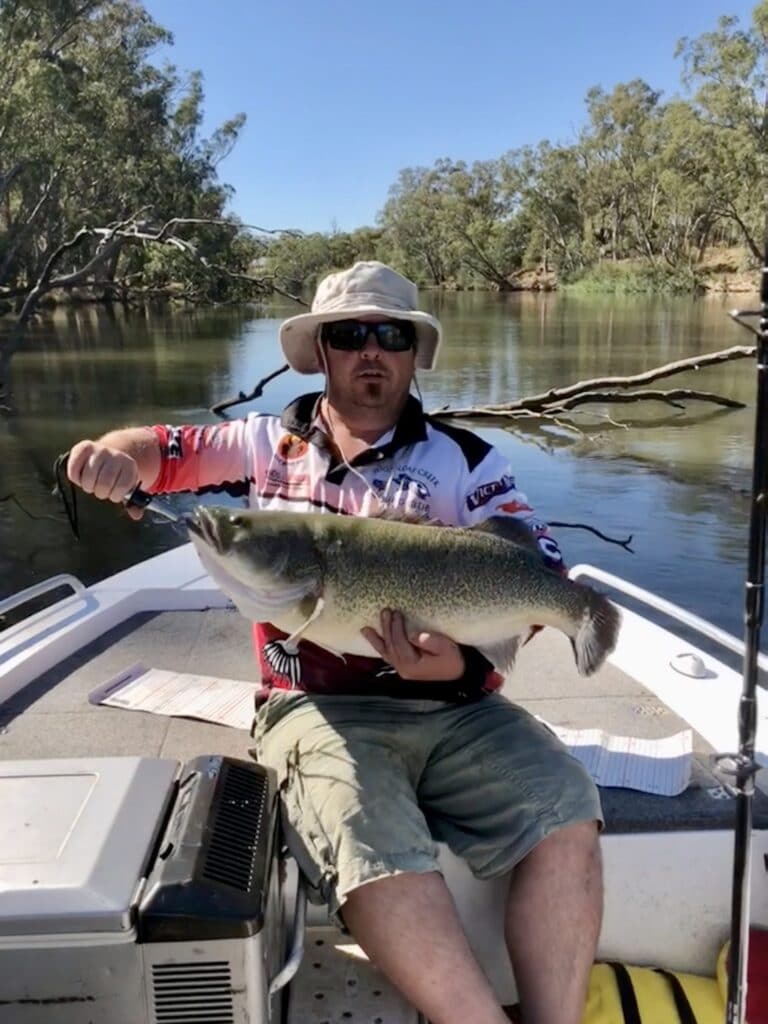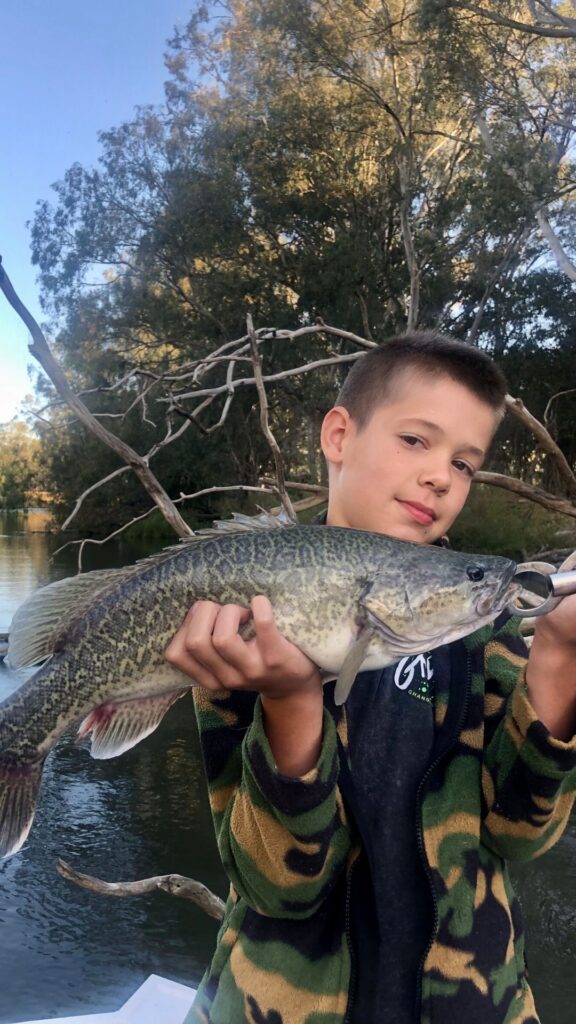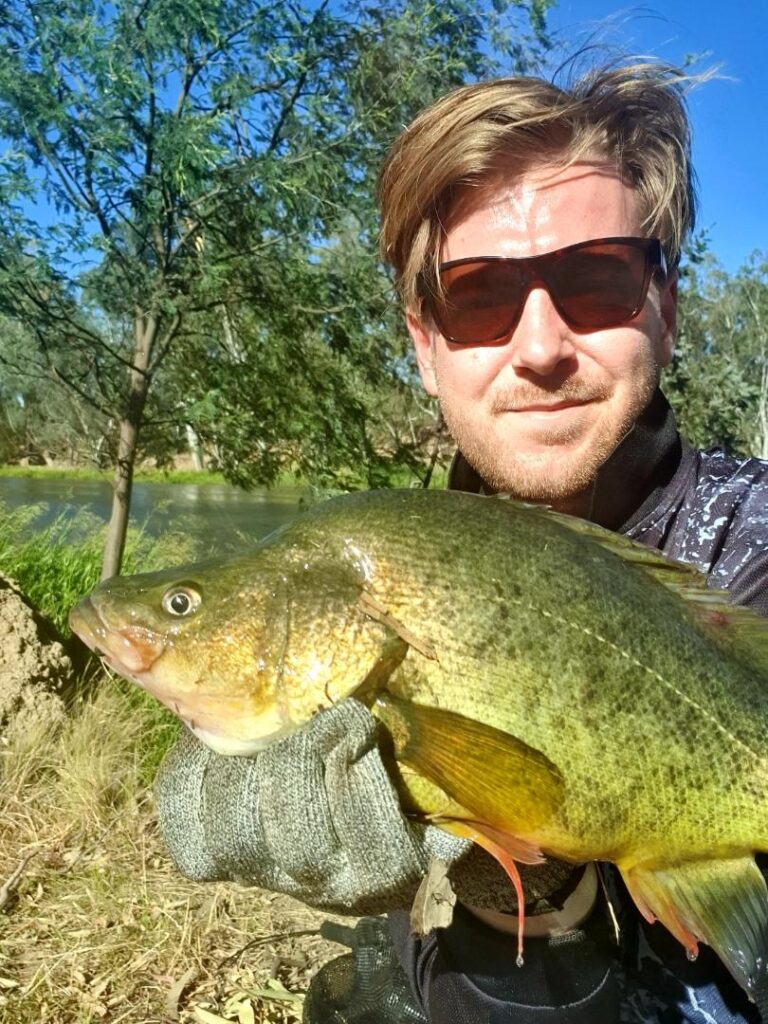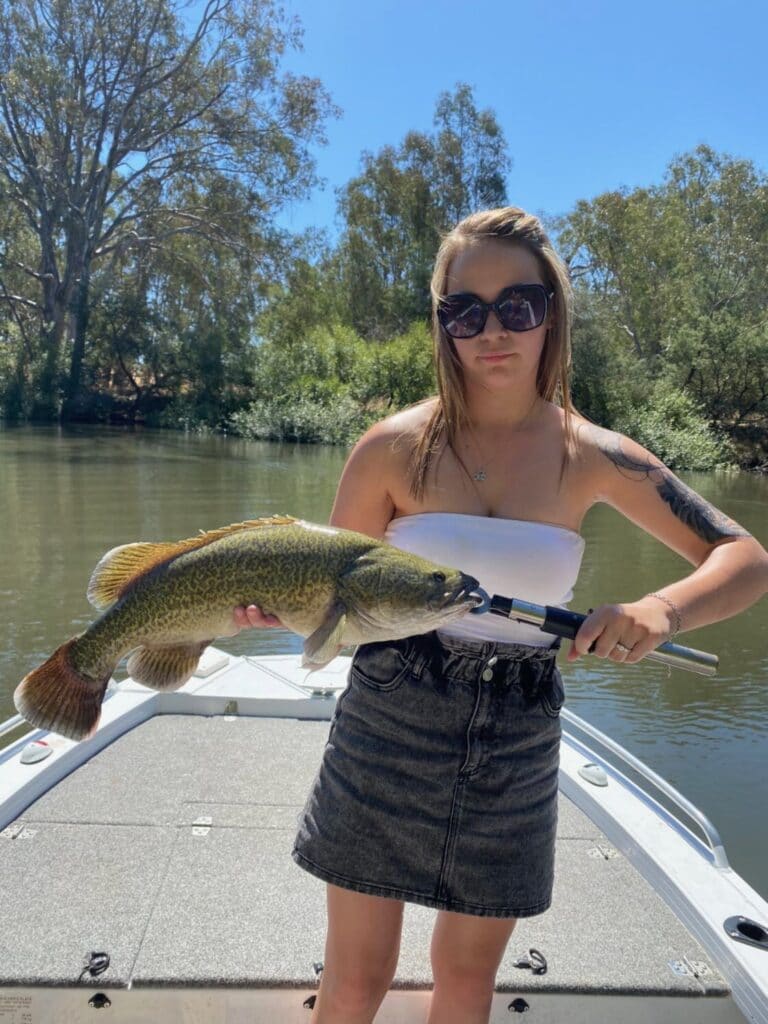HOOK A WINNER
When it comes to catch and release, the fishing gear used and your handling techniques play a crucial role in maximising the post-release survival of fish. Research shows that fish are more likely to survive post-release if they are shallow-hooked or lip-hooked as opposed to deep-hooked. Deep-hooking is a key cause of mortality in released fish and occurs when the hook becomes lodged in the gills, throat or is swallowed into the stomach. All fishing in the GoFish Nagambie fishing tournament is catch and release, with the exception of carp which cannot be returned into Victorian waters. To ensure all caught and released fish live to swim on another day, we have pulled together our top catch care tackle tips including lines, hooks and nets.
Tight Lines
Actively fishing with a tight line can significantly reduce the chance of deep-hooking. Using an appropriate line weight for your target species can also ensure the fish is not played too long. Landing the fish quickly reduces the chance of the fish becoming too fatigued and stressed.
Hooks
When bait fishing, using non-offset circle hooks and barbless hooks reduce the damage to the fish’s mouth and are generally easier to remove quickly. Using artificial lures reduces gut hooking and changing the treble hooks to single hooks is an option.
When removing the hook from a shallow-hooked fish, use long-nosed pliers or other unhooking gear to quickly and gently unhook the fish. It is best to keep the fish in the water while unhooking where possible.
If the fish is deep-hooked,do not try to remove the hook. Instead, cut the line as close to the mouth as you can and leave the hook in place. Over time, hooks will rust away, dislodge or pass through the fish.
Nets
When you land a catch to measure and photograph, the type of net you use to support your fish between landing and measuring can impact their survival post release. A knotless or fish friendly net, made out of a smooth PVC mesh, can significantly reduce the risk of damage to the fins, scales and mucus layer.
KEEP YOUR CATCH WET
When practicing catch and release, one of the best ways to give the fish a better chance of survival is to keep the fish in the water for as long as possible. We’ve put together some of our top tips to keep your catch wet so they can keep on swimming. Before you launch your first cast, be prepared to land a big one. Have a knotless net, cod gloves, a wet cloth and hook removal device ready for when you reel in your prize-winning catch. The more prepared you are, the quicker your catch will be able to swim away.
Reduce fight time by using heavier gear and a tight line. By landing the fish quickly, you can avoid playing the fish to exhaustion which reduces stress on the fish and increases its chances of post-release survival. Using circle hooks and barbless hooks as they reduce the damage to the fish’s mouth and are generally easier to remove quickly.
When handling your catch, you can help the fish to recover by minimising air time and keeping it in the water for as long as possible during handling. The best way to allow the fish to recover while you remove any hooks is to use a knotless, fish-friendly net. Knotless nets are often made from rubber or a smooth PVC mesh which reduces the damage to the fins, scales and mucus layer. They also provide support to the body of the fish reducing internal injury to its organs. Aim to have the fish back in the water within 30 seconds.
When you’re ready to handle the fish, whether you are removing a hook or taking a photo, ensure you have wet hands or a wet cloth ready to minimise damage to the outer body.
When measuring your catch for the GoFish Nagambie tournament, make sure you place the fish on a cool, wet surface. The best way to do this will be to wet your brag mat before you place the fish onto the surface.
For more best practice handling tips, don’t forget to check out the Care for Cod campaign by VRFish, Victorian Fisheries Authority and Native Fish Australia. When practicing catch and release, adopting better handling practices can help our iconic cod to survive post-release. To read more about the Care for Cod campaign, visit the VRFish website https://www.vrfish.com.au/education/campaigns/care-for-cod/
REVIVE TO SURVIVE
After a long fight, fish can be exhausted which can impact their ability to recover quickly and swim away. Their recovery is a major impact on their post-release survival. If the fish is struggling to hold itself upright and unable to swim away, this is a key sign that it needs to recover. We’ve put together some of our top tips to revive your catch so they can keep on swimming to fight another day.
A knotless net is best but if you do need to handle the fish, always use wet hands or gloves to minimise any damage to its skin. Minimising the time the fish is out of the water is essential. To begin reviving the fish, gently hold or slowly push the fish through the water in a slow figure-eight motion to allow a good flow of water and oxygen across its gills.
If there is a current, face the fish upstream and towards the current. When the fish is recovered the fish will generally swim away under its own accord or a by a quick snap of its caudal fin.
CARP
European carp are a noxious pest species and cause major damage to the quality of inland waterways as well as our iconic native fish populations. Carp are extremely prevalent in the Murray-Darling Basin and are a dominate species as carp populations exceed 350 kilograms per hectare in some areas which is why they are often referred to the ‘rabbits’ of our inland waterways. As carp are bottom feeders, they stir up mud and silt as they feed and make the water muddy which impacts water quality, vegetation, native fish and invertebrates. They outcompete with our beloved natives as carp can produce up to one-million eggs per year!
Carp have a negative impact on recreational fishing opportunities, many anglers often see carp as getting in the way of the natives they really want to catch. On the other hand, some anglers do specifically target them and kids love reeling in a huge ‘mud monster’! Carp used to be the prevalent species caught in Nagambie Lakes but thanks to extensive native fish stocking by the Victorian Fisheries Authority and support from local angling clubs the waters have become the native fishing hotspot that we know today.
At GoFish Nagambie, carp are the only species which will not be released back into the water with the intention of clearing as much carp as possible from local waterways. As they are a noxious species, carp do not have a size limit or bag limit for recreational fishers. Fishers are not allowed to return live carp back into the water, instead anglers should humanely kill the carp immediately. The catch is still to be logged via the GoFish Nagambie App. It should be thoughtfully disposed of or brought to the GoFish Nagambie Festival Hub where the fish will be logged and appropriately disposed. Given the number of anglers expected for GoFish Nagambie it is recommended not to return dead carp to the river.
Things are just starting to get interesting on the Goulburn River and Nagambie Lakes. A 114cm Murray Cod was caught near Tahbilk Winery on a delicious cocktail of Chicken and Cheese, a metery was caught downstream of Hughes Creek on a grub AND young Adele pulled in a 103cm Murray Cod trolling an Old Mate diver on the lake. Just call Nagambie meter city!
From the bank, the boardwalk in town is also providing a good return on Murray Cod with an 80cm caught just yesterday.
Getting good numbers of Golden Perch bobbing soft plastics around the willow trees at Kirwans Bridge.
Over the last month, we’ve heard of over 15 fish over the meter mark and plenty more between 60 cm to 80cm caught in the Goulburn, showing just how damn good our fishery is at the moment.
Nagambie Lakes is home to our icon, the Murray Cod, which could win you $80,000 come this April. We are now into 2020 and the competition date is getting closer and closer. Its time to start prepping yourself for a massive competition that could change your life.
With that said, I want to share some tips for targeting cod and how I would go about catching them both during the competition.
Murray Cod
The lake system is full of a healthy population of Murray Cod from plenty of smaller cod in the 45-60cm range, right up to those metre plus models. These large Murray Cod are extremely intelligent and trying to fool them will be difficult, especially when everyone else is trying to chase them as well.
In saying that there are three different tactics that I would use, if you’re chasing that winning fish:
- Use Big Baits: there is no denying that bait is the best way to catch cod. It’s the most natural presentation you can offer, and it will successfully catch fish. Even more so when there are hundreds of lines in the water, you want to have to most natural presentation possible. If you prefer to use bait and you want to go big, use massive baits! Try and catch the biggest yabbies possible, that would be my go to bait, as well as big bardi grubs. Try and find the biggest log or deepest hole, tie up and wait for the big cod to find your big bait.
- Troll Deep: I’ve said it before, that the main river channels hold good quality fish. The largest cod will hold on the edges of the main river bed on the larger structures and in the deep holes. This is how Paul and I landed the 94cm cod while filming the IFISH episode. Trolling lures larger than 100m close to the bottom and close to structure is a go to technique for chasing big cod.
- Shallow Flats: this is the third tactic and probably one of the best to use. The river sees a lot of traffic so trolling and bait fishing the main river could be difficult with the boat traffic close by. A way to move away from the traffic and still find big fish is by moving out onto the flats. You’ll be surprised how shallow cod will go and there are some massive large expanses of water in Nagambie and if you can find these area with at least 1m of water you will find cod, and big cod at that in low light. It’s worth pushing out into the shallow areas and throwing surface lures and swimbaits around the standing and fallen trees as well as the reedy and weedy edges.
Rhys’ Competition Strategy
After covering those three main tactics for chasing that winning cod I want to run through the strategy I would use. The competition runs across two and a half days, and the first thing you need to take away from this, is to fish every moment you get. The more time spent on the water the more chance you’ll have. So don’t give up and keep on fishing.
On the first day is when you’ll have you’re best chance at getting a fish. This first morning I would pick a good trolling run and fish it hard, troll back and forth over your chosen run. Make sure you choose a good troll run with plenty of timber in about 6-7m.
Continue to do this through till mid-afternoon. By this stage the fish may start to becomes a bit shy due to the traffic on the water. This is when I would venture out into the shallow flats and try to find some good water for the evening session. Then I would fish out in these areas, as far away as you can get from other boats fishing with swimbaits and spinnerbaits before using topwater late in the day.
Day two I would use the same technique from the afternoon before. Start with surface then move to swimbaits and spinnerbaits. Once the sun gets up, if you’re keen to bait fish I’d bait fish during the heat of the day in a shaded spot with a deep hole. Then return to fishing the shallow in the evening.
Then the same process for the last half day. This is my game plan so if you’ve taken the time to read this enews you will be ahead of the other competitors.
Good luck with your Nagambie preparations and I’ll be sharing more tips soon!
Rhys
Nagambie is firing up! Plenty of good reports coming in. Murray Cod on bait in the Mitchelton stretch from Mitchellstown bridge back towards Seymour. Bardi Grubs proving to be absolute dynamite. Reports also on cheese, chicken, scrubworms and even the old left-over gourmet sausages coming up with the goods!
Trolling along the deeper water has also proved fruitful. Big hardbodies like AC invaders working well.
If you’re casting, a Bassman Spinner and Jackall Gantarel seems to be the go in the smaller backwater sections.
Still in the same area, Reddies are on the chew for small yabbies and worms.
Further downstream towards the Leisure Park, surface fishing with paddlers on the far side of the river to the caravan park has been producing Murray Cod frequently between the sizes of 60 to 85cm.
If you’re land-based, there are plenty of Redfin and Yellowbelly being caught along the boardwalk towards the old Rowing Club. Bait is doing most of the damage on small worms and yabbies. Also give 3 to 4 inch soft plastics are crack too.
Dan Hawkins is the Executive Chef of Mitchelton, Nagambie Brewery and The Prince Hotel. When he’s not in the kitchen throwing together some of the best food in the business, Dan says, you can find him on the water or in the bush. It’s the pursuit of food through adventure that gets him going. We’re talking hunting, bow hunting, saltwater fishing, freshwater fishing, spearfishing and foraging for wild foods.
TELL US A BIT ABOUT YOU, YOUR CARRER AND GETTING OUTDOORS HUNTING AND FISHING
I am a professional chef by trade. I have been working in commercial kitchens since I was a teenager. I came to Victoria from New Zealand 14 years ago and never left. My most recent appointment was the Executive Chef role of Mitchelton Winery, Nagambie Brewery and The Prince Hotel, St. Kilda.
As a chef I am very passionate about food! In particular, where it comes from. Hunting, foraging, and fishing for my own food was always going to be a natural progression. It is this pursuit of food through adventure that keeps me outdoors wanting to learn more. Hunting, bow hunting, saltwater fishing, freshwater fishing, spearfishing, foraging for wild foods there isn’t much I don’t get stuck into these days.
I would be considered first generation living an outdoors lifestyle. Hunting and fishing isn’t a family tradition passed on from father to son, until now! I am a father of two, family time is camping and fishing and always trying to better each other and catch the bigger fish! When I am not in the kitchen you can find me on the water or in the bush, im always looking for that next adventure.
MY DEFINING FISHING MOMENT IS
Ironically, my defining fishing moment doesn’t involve catching a fish! About 5 years ago, I was fishing a well-known land based snapper hot spot in Corio Bay. I had one rod, knew one knot and only knew how to tie one fishing rig. I was very keen but very green. All of a sudden my rod just buckled, It bent over and I thought it was going to snap into a million pieces. I had no idea about drag, that thing just took off and ended up spooling me for all but about three rounds left on the reel. 150 m of line stripped, I couldn’t stop it running! I felt gutted, I felt like I had just lost the fish of a lifetime and I was never gonna let that happen again.
If I wanted to catch the big fish I had to school up and get serious. I took my gear serious, took my reading and fishing knowledge serious and I started to fish every spare moment often fishing after work until 4 am after working a 14 hour shift in the kitchen. I was literally HOOKED!
I KNOW I’M ONTO A GOOD FISH WHEN
There are a few good tell-tale signs of what kind of weight is on the end of the hook. The initial bite and how aggressive the take is or how big the buckle in the rod is. For me, it’s the drag. When it starts slipping on your standard setting, you know it is a fish holding some serious weight and power.
THE THREE BITS OF GEAR I COULDN’T LIVE WITHOUT ARE
Fishing has that aura of superstition about it. “I can’t fish without my lucky hat” or “I need my particular lure” or the old classic no bananas on the boat!!!!!!
I don’t have any superstitions like this or gear I can’t live without. Rod in hand, hook on the end, I am comfortable.
I do make sure I am equipped for they type of fishing I am doing. This means I have a kit for each adventure. I won’t take my trout kit chasing Cod and I won’t take my salt kit out chasing trout. Each kit will have different bits, but all equally important to that type of fishing.
If you are just starting out in freshwater fishing here are three bits of kit to get you started. I was starting out in the freshwater game 2 years ago, using 8ft snapper rods and large 6000 reels. I was struggling to get bites. They were cumbersome difficult to be accurate with my cast. I had to change the gear quickly.
My starting out kit would include;
A decent rod and reel, something between 5’10 and 6’2. Not too big to be challenging, not so small you are fishing with a kids rod. The length is very important, especially when casting from the bank when you can hit tree branches overhead or from a boat fishing from a shared space.
A pair of polarized sunnies. Polarized sunglasses help with the glare off the water and allow you to see structure under the surface much better than the naked eye. If you can see the structure better, you can better position your cast and you will have a better chance of hooking up.
A decent backpack to carry your kit. If you are walking the bank flicking and moving, you may be doing this for hours at a time. You want to be able to carry all your gear, a water bottle, some snacks and whatever other essentials you may need comfortably. If you are having a challenging time, losing lures, not getting hook ups, you’ve been at it a while and its not working out, you don’t want to call it quits early because you are uncomfortable and have a sore back from lugging your gear around as well.
MY LURE OF CHOICE IS
My favourites are forever changing. Between all the brands, styles, colours and upgrades it’s hard to have a fixed favourite or a go-to. I have recently moved on to Chatterbaits. It is the action in the water and the vibrations they give off that make them so appealing to me.
IF I’M TAKING A FRIEND WHO’S NEVER FISHING NAGAMBIE BEFORE, I TAKE THEM TOO
The strip known as Mitchelton. I have caught loads of fish on the run from the bridge boat ramp up to Majors creek. There are plenty of good holes holding fish, the water quality is very good and it runs deep up the guts. Even land based angling is quite accessible, you don’t have to fight a heap of blackberry to get down to the river banks and there is plenty of visible structure to cast at.
OFF THE WATER, THE BEST THINGS TO DO IN NAGAMBIE ARE
Grab a cold frothy and a pizza from Nagambie Brewery.
Walk the board walk around Lake Nagambie and keep an eye out for the local platypus
Visit Mitchelton Winery, head up the Ashton Tower and check out the Aboriginal art gallery in the cellar.
Check out the historical sites, the Black Caviar statue, browse the antique shops and grab an ice cream from Ma Forbes Café.
HUNTING, FISHING, FORAGING AND COOKING. WHAT’S YOUR BEST CAMP COOKED MEAL YOU’VE MADE?
After a long day in the bush or a full days fishing a vegemite and cheese sandwich can taste like a 5 star meal! Camp cooking for me is all about simplicity. When you cook for a living, day in and day out you are all about refinement and perfection on a plate. Put me in the bush with a cast iron dutch oven and a fire and my go to would be a keyhole roast. A true one pot wonder.
Some of the more memorable meals are the ones that bring the pursuit of your game to the dinner table. Be it wild venison, or goat meat, fish straight from the ocean or river or wild mushrooms in autumn. Once you start to forage and hunt your own food, you start to see food EVERYWHERE. When hunting in Autumn or Spring for wild deer I always check the creeks and streams for wild watercress when I am out – Venison and watercress is great together. Or if I am diving from the shore for reef fish in Port Phillip bay in summer I will always check the intertidal zone for wild sea asparagus (Samphire) and wild fennel that grows on the foreshore. A nice fresh piece of fish with a samphire and fennel salad and you didn’t need to go to the supermarket for nothing!
There is literally edible food everywhere when you start looking.
IF I COULD GO FISHING WITH ANYONE IN THE WORLD IT WOULD BE
Believe it or not it would actually be Paul Worsteling – A local Victorian fishing legend. I have been watching Paul, Cristy and Jet Reef catch fish on iFish since before I even owned a fishing rod. I reckon he would be a great yarn, a wealth of knowledge, a ripper bloke and someone I wouldn’t mind ending up in Wrong-Town with!
I was fortunate enough to meet Paul at Mitchelton while filming the GoFish Nagambie iFish TV special this year which was a highlight for me. It was a bit of a fanboy moment I must say!
I’M EXCITED FOR GOFISH NAGAMBIE BECAUSE
GoFish 2019 we had just recently opened the Nagambie Brewery and Distillery. I wasn’t able to compete or enjoy all the festival hub had to offer. This year will be different! I am going to get to do all of the things I wanted to do last year. I had mates messaging me, “its cod o’clock” now its “carp o’clock” and they were frothing to fish in those windows of opportunity to win big. I could feel their excitement, I am going to get to feel that same excitement at GoFish 2020
I am also looking forward to seeing the hunting and fishing community all come together in one place, share stories, catch up with old faces and meet some new ones and celebrate other people’s successes. Someone is going to win big! If it’s not me, then I will be high-5ing the winner for sure!
Seeing the small town of Nagambie come alive during this time is also a highlight, for a small town, this event really gets the town pumping along. The town is a hive of activity. It is so good to see the local economy have a boom through the GoFish event.
We are well and truly into the heat of summer now! Extremely hot days means increasing water temperatures and this leads to ACTIVE FISH! As the temperature rises the fish become more active which means they need to feed more and it’s a great time to be out on the water fishing.
I’m going to run through some must have lures for chasing cod over the summer months:
SURFACE LURES
Let’s start with a bang! Surface fishing has taken off over the past 5 years and is one of the most exciting ways to catch Murray Cod. Best of all, now is the best time to be doing it. The stinking hot nights and early summer mornings with both paddlers and wakebaits are perfect for Murray Cod.
With so much activity, creatures and bugs getting around, cod are looking up waiting for food to fall into the water. Large cicadas are a major source of surface food at this time of year as well as mice, ducks and moths. What you want to do is imitate these natural food sources.
Small creeks and rivers: 70-120mm paddler
Larger water bodies: 120mm plus wakebaits and paddlers
Shallow reedy areas: weedless surface fogs
Brands and models:
- Gobsmacked – 80mm Paddler, 125mm Leviathan, 175mm Leviathan
- Balista Lures – Hunchback 90, Tremor
- King Hit – Paddlers 200mm, 150mm and 120mm
- Strike Force – 80mm Boof Bait
- Spro Bronzeye King Daddy 90 Frog
- Lunkerhunt Frog
- Barambah Bidjiwong – Baby 145mm, 200mm, 285mm
- Barambah manic Budgie 110mm
- Kingfisher Mantis 110mm
DIVING HARDBODY
Not just a summer lure but an all year-round lure, the diving hardbody is a must. During summer it works best when trolled deeper down in the water column, especially in larger rivers, lakes and dams. Trolling large 150mm plus lures down in the 6-9m mark is perfect fr chasing big fish that sit down in the cooler water during the heat of summer.
Early in the morning and late afternoon casting 70-100mm hardbodies at the bank side structure in river and streams works well. Also using them to cast at the standing timber, which is a great technique at Nagambie.
Casting: 70-100mm, which crash dives (good gauge is 24ft or more)
Trolling: 70-100mm for smaller fish, 110mm-200mm for large fish. At least 30ft for trolling deep in lakes and dams.
Brands and models:
- AC Invader – 70mm 30ft bib, 90mm 24ft & 40ft bib, 120mm 35ft & 40ft bib, 150mm 35 & 40ft bib
- Balista Lures – Dyno 90, Smoke 80, Tremor
- King Hit Diver – 150mm 15ft & 35ft
- Barambah Baby Perch – 8ft & 16ft
- Strike Force – Cod Stalker 80mm & 100mm
- White Crow Warthog
- Custom Crafted
SPINNERBAITS
One of my all-time favourite lures all year round and they are perfect for the active fish during summer. Casting spinnerbaits close to bank side structure, early and late in the day is a great technique along rivers and creeks. As the sun gets up these fish can sometimes become more reluctant to fish on the edges and that’s where trolling with hardbodies comes into play. In saying that if you have thick shade then they will still eat your cast spinnerbait.
In the large lakes and dams casting large spinnerbaits around heavy structure works great for larger cod. For example, this technique works great in Eildon where there is a lot of heavy, dense structure.
Small waterways: 5/8oz coloardo or willow blade
Large waterways: 1 or 1.5oz Colorado or willow blade, large plastic tail and stinger hook.
Brand and models:
There are a massive range of spinnerbaits on the market and many of them work well. As they are all used the same there is only one brand that I use as it has never let me down and this is Mud Guts Spinnerbaits.
Here is a list of the models I use:
- 5/8oz Standard Colorado
- 5/8oz Standard Willow
- 5/8oz Quad Spin
- 1oz Big Quaddie (large quadspin spinnerbait) – chasing big cod in shallow water
- 1.5oz Big Guts – perfect for casting for big dam cod
- 3/8oz Mini Guts – small creek cod and yellas
There are my 3 go-to lures to use over the next few months chasing Murray Cod. It all depends on the situation and the place you are fishing. If you’re visiting Nagambie make sure you pack your surface lures; weedless frogs, small paddlers and some larger wakebaits. Surface will be perfect early in the morning.
Once the sun gets up that’s when you want to tie on your hardbodies and spinnerbaits!

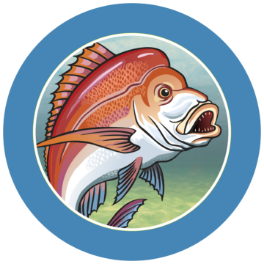 Peninsula
Peninsula 